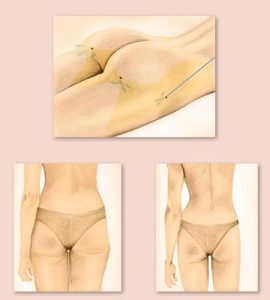Introduction
The following is a presentation to explain the liposuction procedure, which describes how you can best prepare for your procedure, how it may be performed, and your recovery process along with before and after photos of some of our patients. An interesting question and answer section can also be viewed. This presentation is not intended to take the place of a physician’s consultation.
Many people seek liposuction because they want to improve contour and remove fat from specific areas, including hips, buttocks, thighs, neck, arms, chest and abdomen. The best candidate for this procedure is a normal weight person with firm, elastic skin, physically healthy, and with realistic goals and expectations.
Ultrasonic Liposuction
This technique is similar to the tumescent liposuction technique in the fact that predefined areas are filled with tumescent fluid, but then ultrasonic energy is used to liquefy the fat before being removed. This energy is delivered via a rod that emits ultrasonic waves. Your surgeon next inserts the small rod through a tiny incision and massages the fatty tissue before suctioning it out.
Procedure
 What happens during the procedure?
What happens during the procedure?
The liposuction procedure can typically take between thirty minutes to four hours depending on the technique performed and the amount of excess fat removed. Various types of anesthesia can be employed for liposuction including local tumescent anesthesia, conscious sedation anesthesia, and general anesthesia. Your surgeon will discuss which type of anesthesia will best be suited for your specific situation. The two surgical liposuction techniques most commonly used are:
Tumescent Liposuction
This is an advanced form of traditional liposuction that has been performed in the United States since the 1970s. First, your surgeon fills the predefined areas with tumescent fluid which also provides anesthesia (saline mixed with adrenaline and lidocaine). Next, the fat is suctioned out using long thin rods. This entire procedure is done through tiny incisions that are well hidden by the creases of your skin. There are differences in time, costs, scars and other risks.
Preparation Preparing for surgery.
Your initial consultation is extremely important. Be prepared to provide your complete medical history and inform the surgeon of any vitamins and medications (including over-the-counter) that you are taking. Make sure to tell your surgeon if you smoke, have uncontrolled high blood pressure, allergies, blood clotting problems, or tendency to form excessive scars, because these problems can effect the outcome of your surgery. Liposuction carries greater risks if you have diabetes, heart or lung disease, or have recently had surgery in the area you want contoured.
Review With Your Surgeon:
- Do Not Take Aspirin® Or Products Containing Ibuprofen for two weeks before or after your procedure. These medications thin the blood, interfere with normal blood clotting and increase the risk of bleeding and bruising. Instead, use medications containing acetaminophen, such as Tylenol®.
- Discontinue Smoking for two weeks before and after surgery. Smoking constricts small blood vessels and inhibits the healing process.
- Avoid Alcohol for two weeks before and after surgery.
- Decreasing Salt intake will help diminish swelling after surgery.
- Drink Plenty Of Water to help flush toxins from your body.
- Stop Taking All Vitamins And Herbs two weeks prior to surgery.
- Fill Your Prescriptions before your surgery date, especially any pain medication your doctor has prescribed for this procedure.
- Arrange For Someone To Take You Home and to assist you for 24 hours after surgery.
Post Surgery
What to expect post surgery.
- Work: Most patients are back to work within five to ten days. If your job requires you to lift heavy objects, you may need to wait two to three weeks.
- Swelling And Bruising: Swelling can peak within three days and gradually disappear in three to six months. Don’t be alarmed if swelling settles in your knees, ankles, labia, or scrotum. This is normal. Begin walking around as soon as possible to help reduce swelling and prevent blood clots in your legs. Bruising may last two to ten days. Numbness may occur in areas contoured during surgery. Sensation generally returns over the next three months.
- Showering: You may shower per your physician’s instructions.
- Discomfort: The morning after surgery there is some discomfort. However, if you begin to be active and walk around, it should diminish significantly. If you do feel discomfort, take the pain medication prescribed by your surgeon. If discomfort persists, contact your surgeon immediately.
- Recovery: For the next several days, there will be drainage from your incisions. This is mainly leftover tumescent fluid. A drainage tube may be inserted underneath the skin to prevent fluid build-up. If your surgeon sutured your incisions, stitches may be removed or dissolved within five to seven days. You may be asked to wear a compression garment for several days depending on your surgeon’s recommendation. The garment helps your skin fit its new contour. Strenuous activity should be avoided for four to six weeks.
- Results: Final results vary person to person and may be seen after several weeks. Results are permanent but may vary depending on weight gain and aging.
